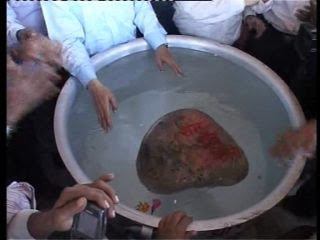 |
| Rama sethu-aerial view |
Rama Setu is a chain of limestone shoals, between Pamban Island,
also known as Rameswaram Island, off the southeastern coast of Tamil Nadu, India, and Mannar Island, off the northwestern coast of Sri Lanka. Geological evidence indicates that this bridge is a former land connection between India and Sri Lanka.The bridge is 18 miles (30 km) long and separates the Gulf of Mannar (southwest) from the Palk Strait (northeast).Some of the sandbanks are dry and the sea in the area is very shallow, being only 3 ft to 30 ft (1 m to 10 m) deep in places, which hinders navigation.It was reportedly passable on foot up to the 15th century until storms deepened the channel: temple records seem to say that Rama’s Bridge was completely above sea level until it broke in a cyclone in 1480 CE.
The bridge was first mentioned in the ancient Sanskrit epicRamayana of Valmiki. The western world first encounters it in "historical works in the 9th century" by Ibn Khordadbeh in his Book of Roads and Kingdoms (ca. 850 CE), referring to it is Set Bandhaior "Bridge of the Sea". Later, Alberuni described it. The name Rama's Bridge or Rama Setu (Sanskrit; setu: bridge) was given to this bridge of shoals in Rameshwaram, as Hindu legend identifies it with the bridge built by the Vanara (monkey-men) army of Rama , which he used to reach Lanka and rescue his wife Sita from the Rakshasa king, Ravana, as stated in the Sanskrit epic Ramayana.
The sea separating India and Sri Lanka is called
 Sethusamudram "Sea of the Bridge". Maps prepared by a Dutch cartographer in 1747, available at the Tanjore Saraswathi Mahal Library show this area asRamancoil, a colloquial form of the Tamil Raman Kovil (Rama's Temple) Another map of Mogul India prepared by J. Rennel in 1788 retrieved from the same library called this area the area of the Rama Temple Many other maps in Schwartzberg's historical atlas and other sources call this area with various names like Koti, Sethubandha and Sethubandha Rameswaram along with others.Valmiki's Ramayanaattributes the building of the bridge to Lord Rama in verse 2-22-76. The earliest map that calls this area Adam's bridge was prepared by a British cartographer in 1804, probably referring to an Islamic legend, according towhich Adam used the bridge to reach Adam's Peak inSri Lanka, where he stood repentant on one foot for 1,000 years, leaving a large
Sethusamudram "Sea of the Bridge". Maps prepared by a Dutch cartographer in 1747, available at the Tanjore Saraswathi Mahal Library show this area asRamancoil, a colloquial form of the Tamil Raman Kovil (Rama's Temple) Another map of Mogul India prepared by J. Rennel in 1788 retrieved from the same library called this area the area of the Rama Temple Many other maps in Schwartzberg's historical atlas and other sources call this area with various names like Koti, Sethubandha and Sethubandha Rameswaram along with others.Valmiki's Ramayanaattributes the building of the bridge to Lord Rama in verse 2-22-76. The earliest map that calls this area Adam's bridge was prepared by a British cartographer in 1804, probably referring to an Islamic legend, according towhich Adam used the bridge to reach Adam's Peak inSri Lanka, where he stood repentant on one foot for 1,000 years, leaving a large
the bridge are named afterthis legend.
Adam's Bridge starts as chain of shoals from the Dhanushkodi tip of India's Pamban Island and ends at Sri Lanka's Mannar Island. Pamban Island is connected to the Indian mainland by 2 km long Pamban Bridge. Mannar Island is connected to mainland Sri Lanka by a causeway. The border between India and Sri Lanka is said to pass across one of the shoals constituting one of the shortest land borders in the world. Adam's bridge and neighbouring areas like Rameswaram, Dhanushkodi, Devipattinam and Thirupullani are mentioned in the context of various legends in Ramayana.
 | |||
| Floating stone of rama setu |
This entry was posted
on Thursday, February 14, 2013
at 1:36 AM
. You can follow any responses to this entry through the
comments feed
.





